7 Best Salmon Trolling Rods (2023 Review & Buyer’s Guide)
UPDATED 19 SEPTEMBER 2023
by Robert Ceran
This article may contain affiliate links. If you make a purchase after clicking on a link we may earn a small commission at no extra cost to you.
Are you looking for a new salmon trolling rod, but not sure which model is right for you?
My team and I tested the best trolling rods for salmon on the market, and evaluated them based on their power, ability to perform well with downriggers or planer boards, and overall performance.
Based on our testing, here are our picks for the best salmon trolling rods in 2023:
- Best overall: Okuma Guide Select
- Best budget: Okuma Classic Pro
- Best for downriggers: Lamiglas Classic Glass
- Best combo: Okuma Great Lakes Trolling Combo
- Best lightweight option: KastKing Krome Salmon
- Best for freshwater: G Loomis E6X Salmon/Steelhead
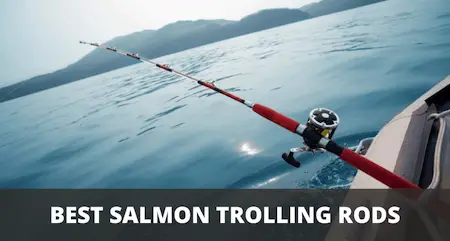
What are the best salmon trolling rods in 2023?
The table above compares the most important specs of the top 7 trolling rods for salmon that we tested.
Ideally, the best salmon trolling rods need to have 3 key characteristics:
- They need to be long (minimum 8 feet)
- They need to have plenty of power (or rod backbone)
- They need to have plenty of flex
Keep in mind that all of the trolling rods above are designed to be used with conventional reels (aka round baitcasting reels).
This is an important point to note, since our testing revealed that spinning reels are not ideal for salmon trolling, and so we don’t advise that you use a spinning rod and reel setup for this kind of fishing.
Let’s dive into the details and take a closer look at each of the best salmon trolling rods in turn.
1. Okuma Guide Select Classic
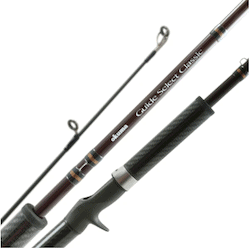

For most anglers, the Okuma Guide Select Classic is the best trolling rod for salmon fishing overall, since it can handle almost any kind of salmon fishing scenario, from using a deep water downrigger, to using a 3 pound leadball to weigh down your lure.
Made of fiberglass/carbon composite material, our tests showed that it combines strength with a precisely designed moderate taper to handle big salmon.
The combination of this design with the strong material make this one of the most durable Okuma trolling rods, which is ideal for big salmon.
During our testing we also found that the blank material of this trolling rod for salmon is ideal for working with a downrigger, and can easily handle being bent all the way down to the water for extended periods of time, which is necessary for this kind of fishing.
Features:
- Fiberglass/carbon composite blank material
- Moderate taper designed for big salmon
- Fujii reel seats
- Stainless steel guides with alconite inserts
2. Okuma Classic Pro GLT Trolling
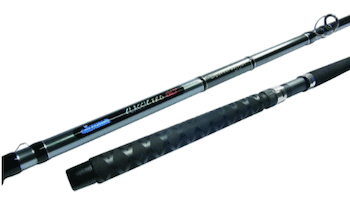

This classic rod is the best salmon trolling rod if you’re on a tight budget. At less than 50 dollars it provides incredible value for money.
At that price you don’t need to worry about breaking it, since it’s so cheap to replace it.
The budget friendly price is due to the fact that the blank is made 100% out of fiberglass, which is much cheaper than carbon.
Our testing revealed that this trolling rod is highly durable, which is essential for the punishing environment of this kind of fishing.
Many salmon anglers like to use multiple trolling rods for salmon, with up to 12 active rods rigged on the boat at a time. Needless to say, that can get quite expensive if all of them are high end models.
However, with the Classic GLT you can buy 3 or 4 trolling rods at the price of one, which makes it one of the best salmon trolling rods on a small budget (which is also why we included it in our best walleye trolling rod review).
Features:
- Highly durable fiberglass build
- Specifically designed for downrigging
- Double footed line guides with titanium oxide inserts
3. Lamiglas Classic Glass
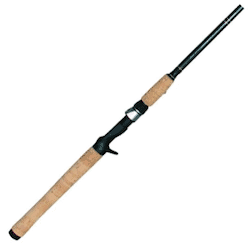

Lamiglas are famous for their high quality rods, and this model is no exception.
The Classic Glass was specifically designed by the Lamiglas team as a trolling rod for salmon with a downrigger, and you’ll find them as the go-to rod for salmon fishing on many salmon charter boats.
The blank is made of pure fiberglass, and during our testing we found that this guarantees a high level of durability. In addition, the trolling rod has a very smooth action due to the precision taper of the blank.
When we put this trolling rod for salmon to the test, we found that the fiberglass plus its moderate action is ideal for having the Classic Glass bent down to the water surface all day long while downrigging.
In addition, the shorter version of this trolling rod is actually light enough to use with a kayak, in case you like to troll for salmon from a kayak or other small boat.
Features:
- Ergonomic full cork handle
- Highly durable 100% fiberglass build
- Specifically designed for salmon fishing with downrigger
- Double footed line guides
4. Okuma Great Lakes trolling combo
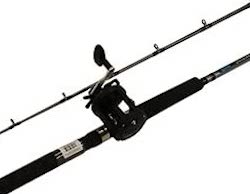

The Okuma Great Lakes trolling combo is the best salmon trolling rod and reel combo.
When we put it to the test, we found that the carbon/fiberglass composite material combines the lightness of graphite with the strength and durability of fiberglass.
The biggest advantage of this combo is that it comes with the Okuma Magda, which is a high quality line counter reel.
As you probably know, you need a good conventional reel to use with a trolling rod for salmon, and if you get the Okuma Great Lakes combo, you’ll get both together.
The line counter on the Magda reel is great for adjusting the depth at which you’re presenting your bait.
This salmon trolling rod and reel combo was specifically designed for heavy duty trolling, and can be readily used with a downrigger.
The rod comes with a clear tip, which helps to spot strikes, and the reel has a bait clicker, which also helps to detect a fish pulling line off the reel.
Features:
- Reel with line counter
- On/off bait clicker
- Carbon/graphite composite blank material
- EVA grips
5. G Loomis E6X Salmon/Steelhead rod
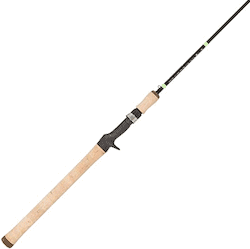

This trolling rod for salmon is more lightweight than the other options discussed above, and our testing showed that this is ideal if you’re going to be fishing in freshwater, as in the big lakes.
When we put it to the test, we found that it’s strong enough to handle abuse, but still light enough to enjoy the fight with a smaller fish when trolling for lake trout or coho.
We found that even under punishing conditions, the pure fiberglass blank of this trolling rod for salmon is incredibly strong, while the tip has a soft action, which is ideal for this kind of fishing.
It’s also surprisingly lightweight for a fiberglass rod, which is partially due to the graphite handle.
Features:
- Pure fiberglass blank
- Graphite handle
- Cork grips
- Soft action tip
6. KastKing Krome Salmon
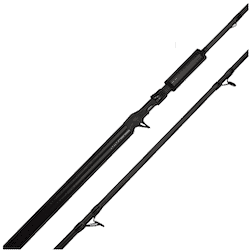

This is another rod on this list which is better for more lightweight applications. It’s the only one we included that isn’t made of fiberglass, or fiberglass composite.
Our testing revealed that it isn’t as durable as the other models, and shouldn’t be used for heavy duty deep water fishing with a downrigger.
But if used in more lightweight scenarios, such as freshwater trolling, this rod is lots of fun to use, since it’s sensitive enough to let you feel a fish fighting on the other end of your tackle. Again, our testing showed that this is an ideal rod for smaller coho or kokanee salmon.
The KastKing Krome is also light enough to be used as a heavy rod for throwing lures.
Features:
- High modulus carbon blank
- Fuji guides & reel seat
- Fluorescent tip for indicating strikes
What to look for in a salmon trolling rod
Some rods are specifically designed for salmon trolling, but based on our testing you can actually use any trolling rod for this purpose, as long as it fulfills all the necessary requirements.
Most trolling rods used for this kind of fishing need to be compatible with downriggers, while a second option is to use a heavy 1-3 pound leadball weight.
Both of these methods of trolling require having a trolling rod with the following characteristics:
- Minimum length should be 8 feet
- Medium to heavy power
- Plenty of flex
Let’s look at each of these in more detail:
Length
For this kind of fishing, you need a trolling rod that’s at least 8 feet long, and the longer the better, in most cases. Some of the best trolling rods for salmon are 9 to 12 feet long.
During our testing we found that there are several reasons for this: if you’re using a downrigger, the rod will be bent down to the water surface by the weight of the downrigger.
When a fish grabs the bait, the line is released from the downrigger, and as a result the tip of your trolling rod shoots up into the air.
The longer your rod is, the more slack line it will pull up in the moment of release, which helps to set the hook as fast as possible, before the fish can spit out the bait.
Secondly, if you’re using a long leader with a flasher on it, you need a long rod to pull a hooked fish close enough to the boat for netting.
If you’re not using a downrigger, but working with a large leadball to weigh down your bait, then a long trolling rod helps to spread out the baits of several trolling rods as far apart as possible.
For more information on fishing rod length, and which one is best for trolling, check out our fishing rod length guide.
Rod power
Needless to say, the best salmon trolling rods should be on the heavy end of the scale. Not only do you need to fight big salmon that like to do powerful dives, but the trolling rod also needs to be able to handle the weight of the downrigger without problems.
If you’re fishing with a big leadball of up to 16 oz, your trolling rod for salmon needs to handle the weight of the leadball while it’s being pulled by the boat, which generates lots of water resistance.
Imagine having a leadball of 16 oz on your line, and then paying out 200-300 feet of line.
This causes immense strain on your whole gear as it is pulled by the current and the boat, and your trolling rod needs to be sufficiently strong to handle this.
Because of this, most trolling rods for salmon are at least medium to heavy power. The only exceptions are trolling rods intended for lighter freshwater applications.
For an in-depth look at rod power, read our article fishing rod weight rating explained.
Flexible action
As mentioned above, if you’re using a downrigger, the tip of your trolling rod is pulled down almost to the water surface.
This works best with a trolling rod for salmon that has moderate action, since it bends not just at the tip, but also halfway down the backbone.
Fast action trolling rods are generally not ideal for this, since they only bend at the tip. Also, more flexibility helps to spread the load carried by the blank, so it’s distributed along the whole length.
For a deeper insight into rod action, and which one you should choose, take a look at our article fishing rod action explained.
Rod material
Due to the extreme strain put on salmon trolling rods, they need to be built with highly durable material. In most cases, the best trolling rods for salmon will be fiberglass, or a fiberglass/graphite composite material.
Graphite trolling rods are much lighter, which is great when you’re spinning or casting, but for this kind of fishing that’s not really necessary.
On the other hand, graphite is more brittle than fiberglass, and as a result graphite trolling rods break more easily when they are deformed under intense pressure.
The only exception to this would be if you’re fishing for coho or kokanee, which tend to be smaller than other salmon species.
In that case a lighter trolling rod for salmon is more fun to fish with, since you can feel the fish fighting on it. But if you’re going for trophy sized king salmon or Atlantic salmon, you definitely need to use stronger material.
Another reason for fiberglass as the preferred blank material for trolling rods is that it performs better with downriggers.
As mentioned above, when your trolling rod for salmon is set up with a downrigger, it tends to be bent all the way down to the water surface, and can often stay that way for many hours.
Graphite trolling rods are more likely to break under conditions like this, compared to fiberglass.
Some anglers report that graphite fishing rods can break when you load them on the downrigger, while others report that these trolling rods sometimes break when they are released from the downrigger.
Spinning vs casting setup
You may be wondering if you can use a spinning setup as a trolling rod for salmon, but that’s not something I would recommend.
Especially if you’re going to use downriggers, you’ll be fishing in very deep water of 100-200 feet or even more.
Spinning reels just don’t have the capacity for that much line. Instead you need to use a round conventional reel, which has more line capacity than any other reel type.
For a detailed comparison of the two rod types, check out our article spinning rod vs casting rod.
Also, if you’re trolling for salmon, you may want to use a line counter reel. These are specifically designed to be able to measure the amount of line you pay out.
When you combine that information with the weight you’re using on your salmon fishing setup, plus the speed of the boat, you can estimate fairly accurately at what depth you’re fishing.
Using a line counter reel on your trolling rod for salmon is a great way to target specific depth ranges when you’re not fishing with a downrigger setup.
Number of line guides
The number of line guides on a trolling rod for salmon doesn’t seem like a very significant factor to most anglers, but for this kind of fishing it makes a real difference.
The best salmon trolling rods tend to have more line guides than other rods, since this helps to distribute the weight loading of the trolling rod backbone more evenly along their whole length, which is essential for getting a smooth bend when you’re working with a downrigger.
Conclusion
This wraps up our article on the top 7 trolling rods for salmon. To summarize: you need a sufficiently strong rod for salmon trolling, that comes with a minimum length of 8-10 feet, and has a flexible backbone that can handle a lot of bending by heavy weights and big fish.
If you’d like to go salmon fishing, but aren’t sure where to go, check out our article explaining where the best places to catch salmon in the United States are.
Methods and gear used for testing the best trolling rods for salmon
For consistent testing results, we tested each trolling rod under similar conditions by trolling on Lake Ontario. We paired all of the trolling rods for salmon with the same reel, a Okuma Convector line counter reel, spooled with 40 lb test Power Pro braid leading to a 18 lb test fluorocarbon leader. We tested each trolling rod with either a lead ball rig or with a downrigger.






